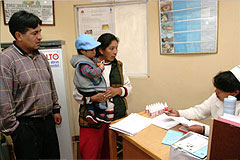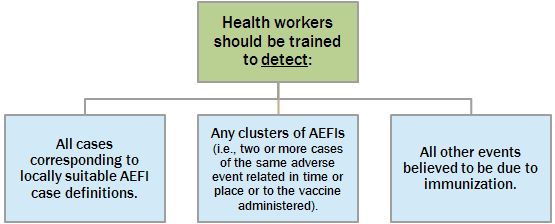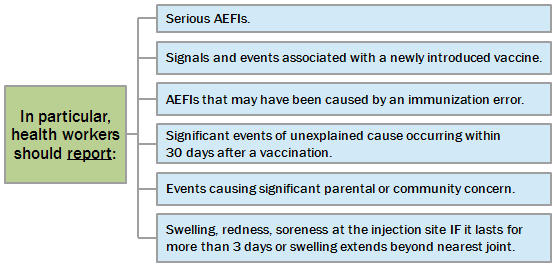Detection and reporting
Stakeholders

Parents of immunized infants/children, health workers at immunization facilities and staff of accident and emergency rooms in hospitals are most likely to recognize or detect AEFIs when they first occur.
Health workers have the responsibility to detect AEFIs and report AEFIs when appropriate. They also have the responsibility to treat or refer patients for treatment. All vaccination staff must be able to diagnose adverse events. Detection requires effective staff training and education to ensure accurate diagnosis of AEFIs based on clear case definitions, which can be included on the AEFI reporting form and in the national AEFI guidelines.

Immunization programme managers should establish appropriate criteria for detecting AEFIs by identifying adverse events of importance to the programme in their country.
Which AEFIs should be reported?
Key point
Any AEFI that is of concern to the parents or to the health care worker should be reported.

In addition to deciding which adverse events should be reported, it is essential that immunization programme managers define the roles and responsibilities of stakeholders, clarify on the process of reporting, and how to ensure/encourage reporting. The following questions should guide the immunization programme manager when setting up and maintaining a detection and reporting mechanism.
- Make sure that health workers are aware of their responsibility to report AEFI.
- Reporting should be as standardized as possible, best done through an unambiguous and standardized reporting form.
- This may depend on the local context. Keep in mind that with unclear responsibilities among stakeholders, there is the danger of double-reporting or under-reporting. Make sure that reporting lines are simple and direct and clear to all stakeholders involved.
- Any AEFI that is of concern to the parents or to the health care worker should be reported. See above for a list of events that must be reported.
- Health workers may be afraid of getting penalized for reporting. It is important that reporting health workers understand that adverse events following immunization – related to the vaccine or not – must be expected and can happen independent of the health worker’s action.
Question
Case definitions support reporting of standardized diagnoses, which provides investigators with data that is comparable. Which of the following statements has or have not been reported in line with the examples of standard case definitions of the Brighton collaboration provided and may therefore lead to misinterpretation of data? Select one or more:
| A. "Child developed high fever" (temperature measured was 41 degree Celsius). | |
| B. "The child suffered from afebrile seizures" (body temperature was normal). | |
| C. "A severe local reaction occurred at the injection site" (the occurred swelling extended beyond the nearest joint and lasted for 3 days). | |
| D. "Patient developed symptoms of encephalopathy due to vaccination with DTP given 4 weeks before occurrence of symptoms". |
Answers B and C are correct.
- Answer A: According to the Brighton Case definition, fever higher than 40.5 degree Ceslsius is "extreme".
- Answer D: To be due to DTP vaccination, encephalopathy symptoms should occur within 48 hours of vaccination.

